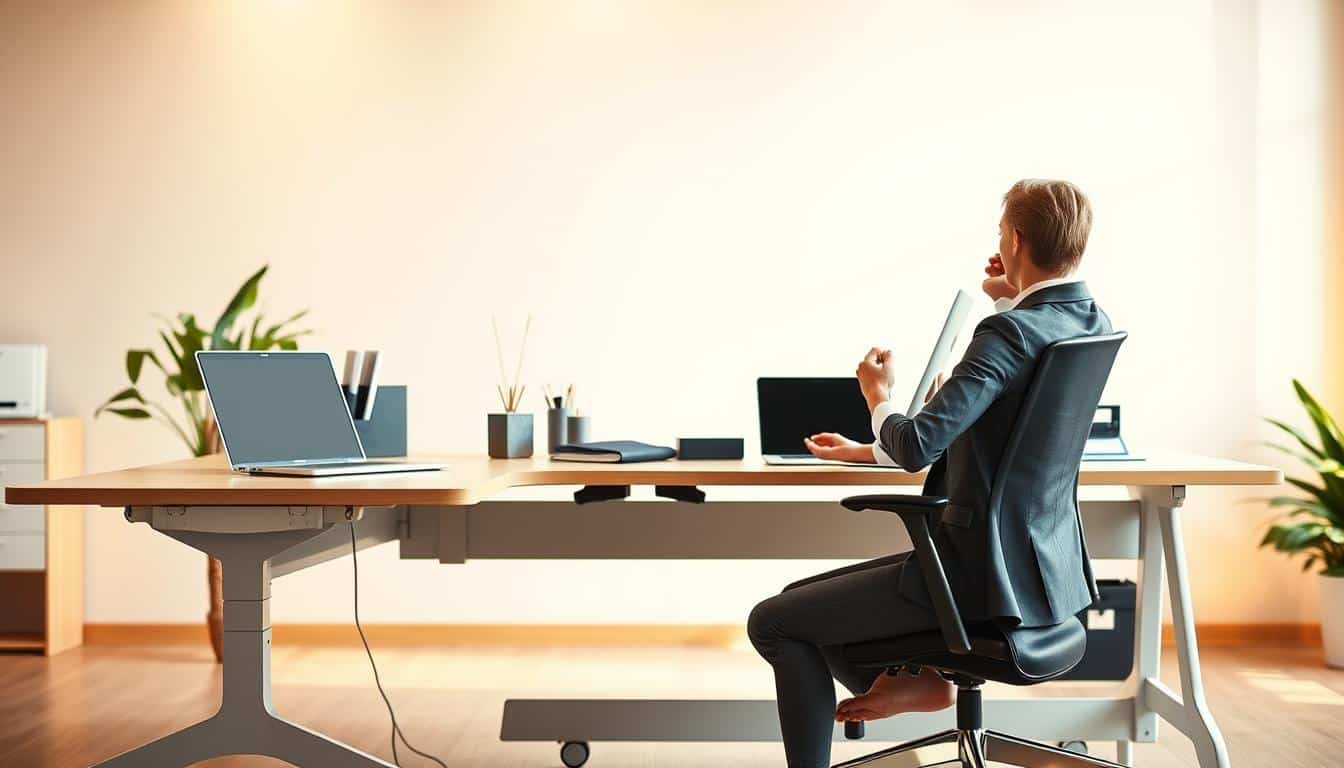In our busy work life, stretching is key to staying healthy and productive. Most Americans sit around 6.5 hours daily. This increases the risk of heart problems and bad posture. By adding simple exercises to your day, you can see big health improvements. These include better blood flow, less stress, and clearer thinking. This piece looks at easy stretches for any work situation, improving your day.
Understanding the Importance of Workplace Stretches
Workplace stretches greatly improve wellness and employee health. Sitting for too long causes muscle stiffness and potential health issues. Regular stretching helps avoid these problems, making employees feel better during their workday.
Experts suggest taking 5-10 minute breaks every hour to prevent muscle strain and boost productivity. Stretching workouts focus on the neck, shoulders, back, and legs. These moves lower muscle tension and better circulation reduces discomfort.
Organizations that push for healthy work habits make employee well-being a priority. For stretches to work, avoid pushing too hard and breathe normally. If stretching causes pain, it’s important to stop immediately.
Every year, over 600,000 injuries are related to musculoskeletal disorders (MSDs), causing 34% of missed workdays. Making stretching part of the work routine can counter that. Stretching makes muscles more flexible and improves movement. It also cuts down on fatigue by boosting blood flow and bringing nutrients to joints.
Adding stretching to daily work life improves muscule coordination and leads to better posture. A system called Work Readiness System supports a healthy, safe work culture. This boosts worker dedication and productivity. Teaching the value of stretching brings clear benefits to personal health and job output.
Health Risks of Sedentary Work Environments
The way we work has changed a lot, but many of us still sit too much. This bad habit increases health risks and hurts our mental health. Knowing about these problems can help make work healthier and more productive.
Common Issues Associated with Prolonged Sitting
Sitting too much can hurt your health without you even knowing. With workers sitting almost 10 hours a day, they face problems like:
- Neck and shoulder pain
- Lower back pain
- Obesity
- Carpal tunnel syndrome
- Chronic knee pain
These problems are linked to sitting for over 10 hours a day. Solving these issues can help prevent pain and improve health at work.
The Impact on Mental Well-Being
Sitting a lot harms not just the body but also the mind. It leads to stress and depression. Studies show not moving enough makes mental health worse. This affects how happy and productive we are at work.
It’s important to understand how sitting too much harms both body and mind. Workplaces need to take steps to reduce these risks.
Benefits of Incorporating Stretching into Your Workday
Adding stretching to your day at work has many great benefits. It does more than just make you flexible. Stretching helps prevent injuries and can make you more productive. It fights the problems that come from sitting too long, like tight muscles and other health issues.
Physical Benefits and Injury Prevention
Stretching often is really good for people who sit all day at work. It helps in many ways:
- It makes muscles less tight and helps you relax by making short muscles longer.
- It increases flexibility and makes your joints move better.
- It gets your blood flowing better, which brings oxygen and nutrients to your body parts and gets rid of wastes.
- It stops injuries at work by fixing uneven muscles and bad sitting positions.
Doing simple stretches, like moving your neck, shrugging your shoulders, and bending to the side, is easy and effective. These moves are key to avoiding serious problems caused by sitting too much, such as deep vein thrombosis and ongoing pain.
Enhancing Mood and Mental Clarity
The emotional benefits of stretching are just as great. Stretching regularly can really improve your mood and clear your mind. It boosts blood flow and releases feel-good chemicals, making you feel happier and more focused. Stretching also fights tiredness, refreshes your brain, and makes you more focused and productive all day.
Taking short breaks to stretch every 30 to 60 minutes can truly change how happy and healthy you feel at work. It makes the workday more lively and fun.
Simple Desk Stretches for Every Office
Doing simple desk stretches at work can really help your health and work performance. They don’t take up much room or time. Adding arm and leg stretches to the workday can make you feel more awake and focused.
Stretching Out Your Arms and Shoulders
Stretching your arms is key to easing shoulder and upper body tension caused by sitting too long. Here are some great methods:
- Triceps Stretch: Lift an arm up, bend it at the elbow, and softly pull with the other hand.
- Overhead Reach: Stand, reach your arms up, and tilt a bit to one side for an extra stretch.
- Shoulder Roll: Move your shoulders in circles going back and then forward to ease stiffness.
Leg and Knee Stretches
Stretching your legs helps beat sitting effects and boosts blood flow, keeping you energized. Give these a try:
- Knee Hug: Sit and draw one knee to your chest, hold, then swap legs.
- Seated Leg Extension: Straighten one leg in front of you with the other foot on the ground. Pause, then switch.
- Chair Leg Stretch: Place your leg on another chair and lean forward for more stretch.
Stretching regularly reduces muscle strain in your hips, lower back, neck, and shoulders. It also enhances circulation and posture. Taking short breaks for these stretches can give your eyes a rest and lower the tiredness from staring at screens, helping you stay productive longer.
Integrating Workplace Stretches into Your Daily Routine
Putting stretches into your work day is key for health and staying alert. You can do small movements like moving your shoulders, stretching your wrists, and straightening your legs even when you’re sitting. Set times to stretch during the day, maybe after meetings or in the morning.
Make good use of your free moments. Doing quick leg stretches or turning your neck and shoulders can ease stress. Try stretching at different times, like when watching TV or cooking, to keep flexible and lessen muscle stiffness. This method helps with daily activities, boosting coordination and muscle strength.
When stretching, make sure it feels good and breathe deeply. This way, each stretch is more effective. You can stretch anywhere – at home, work, or on the go – to keep focusing on your health.
Stretching often helps with your posture and balance, important for those who sit a lot at work. Making it a regular part of your day can ease issues from sitting too long. Better posture means fewer injuries over time.
Also, stretching makes you feel happier by releasing feel-good hormones, cutting down stress and worry. This can lead to better work output, creativity, and decision-making. Adding simple activities to your day can improve how you feel overall, changing your day-to-day life.
Upper Body Stretches to Alleviate Tension
Adding upper body stretches to your day helps ease tension. This is really useful for those sitting at desks for hours. These moves ease neck pain, make you more flexible, and boost your well-being. Each stretch focuses on different upper body parts to relieve sitting-related pain.
Neck and Shoulder Relief Techniques
To reduce neck pain, try these methods:
- Neck Rolls: Gently roll your neck to loosen stiffness.
- Seated Lateral Stretch: Sit, hold your chair’s bottom, and stretch over with the other arm for a neck stretch.
- Pec Stretch: Stand by a wall, arm out, then turn away to open up your chest and shoulders.
- Neck Flexor Stretch: Tilt your head back, maybe with a towel for help, to stretch your neck muscles.
Wrist and Arm Stretches for Desk Workers
Wrist stretches are great for those doing repetitive tasks. They increase comfort:
- Wrist Extensions: Press your palm on a wall with a straight arm. Lean back to stretch your forearm.
- Chair Rotations: Twist your body using a chair to reduce shoulder and back tightness.
- Arm Circles: With arms out, rotate them in small circles to prepare your shoulders.
- Overhead Arm Reaches: Lift your arms up to stretch all over and better your posture.
Lower Body Stretches to Counteract Sitting
Lower body stretches help fight the bad effects of sitting too much. Doing these stretches often eases leg pain and makes moving easier. Try crossing one ankle over your other knee and leaning forward. This stretch is good for your hips and glutes. It helps ease the tightness from sitting a lot.
A hamstring stretch can make a big difference too. Just extend one leg, then bend over to touch your toes. This keeps your hamstrings flexible, cutting down on leg pain. Then there’s the hip flexor stretch for the front of your hip. It boosts flexibility and helps with walking and stairs.
Calf stretches are key for your legs’ health. You can do them standing or sitting. They target your calves and hamstrings. This improves how you walk and lowers falling risks. Add a seated glute squeeze to your day. It works your buttocks and hips, helping you move better and feel less stiff.
Doing these lower body stretches every day can improve blood flow, reduce pain, and give you more energy. They are a must for those who sit a lot during their day.
Core Stability Exercises for a Stronger Posture
Today, many of us sit more than we should. This makes keeping your core muscles strong very important for your posture and back health. Doing core stability exercises often can help you feel better and improve your health. You can do these exercises at your desk or home, even when you’re really busy.
Engaging the Abdominals at Your Desk
Here’s how to work your core while sitting:
- 90-90 Iso Holds: Lie down and bend your knees. Lift your knees up, press your hands against your thighs, hold for up to 15 seconds, then lower. Do this more times for better results.
- Dead Bugs: Lie down, bend your knees and keep arms at your sides. Then raise your arms, brace your belly, and straighten one leg while lifting the opposite arm. Switch sides for ten times, keeping stable as you move.
- Modified Side Plank with Clam Shells: Lie on your side, knees bent, and lift your hips while tightening your glutes. Use resistance bands to make it harder if you like.
Back Stretches for Better Spinal Health
Along with core exercises, stretching your back is key for a healthy spine. Try these stretches:
- Supine Figure Four Stretch: On your back, lift one leg and rest your ankle on the other knee. Hold your thigh and pull towards your chest, 30 seconds each side.
- Child’s Pose: Kneel, sit back, and reach your hands forward for a gentle stretch.
- Half-Kneeling Hip Flexor Stretch with Overhead Reach: Kneel and step one leg forward, lean into it as you reach up. Switch sides after.

Doing these core exercises often helps make your posture better and lowers the chance of back discomfort. By adding these stretches and moves to your daily schedule, your back gets stronger and you’ll stand taller.
Making Stretching a Habit: Tips for Success
It’s important to stretch regularly for your health at work. Start with clear, achievable goals. Keep track of your progress to stay motivated. Start with 1 to 5-minute sessions to easily fit stretching into your day.
Put things like a yoga mat or foam roller where you’ll see them. This reminds you to stretch throughout the day. Also, stretch when you’re already taking a break or waiting for a meeting. Use fitness apps or smartwatch reminders to keep on schedule.
Listen to your body for signs you need to stretch, like muscle tightness. Take short breaks to move every 30 to 45 minutes. This keeps you productive and prevents injuries from sitting too long.
Get your co-workers involved to build a wellness culture. Stretching together can be fun and keeps everyone motivated. Stretching is great for your body and mind. It makes a big difference in feeling good and working well.
Incorporating Movement into Your Workday
Making sure you move during your workday is key for staying healthy and productive. Taking moments for short exercises at your desk helps. It lessens stress and refreshes workers. Knowing the value of quick, purposeful breaks can boost work performance all day.
Quick Exercises You Can Do at Your Desk
Adding short exercises into your desk routine is not hard. Think about trying these activities:
- Perform partial squats while waiting for the copier or microwave.
- Do calf raises or stand up and march in place while on the phone.
- Utilize a resistance band for quick strength training exercises in the office.
- Take a 5-minute dance break to your favorite tunes.
- Keep small hand weights for quick bicep curls or lateral raises.
- Stretch your wrists, arms, and neck after long typing sessions.
- Encourage microbreaks every hour that involve stretching exercises such as lunges or shoulder rolls.
Using Breaks Wisely for Stretches and Movement
Using breaks smartly to move more at work is vital. Try strategies like:
- Scheduling regular movement breaks on your calendar to keep it consistent.
- Joining a mid-morning stretching group for fun and to meet others.
- Walking to refill your water bottle to stay hydrated and get moving.
- Taking a 10-minute yoga session during your break to relax and find focus.
- Creating a virtual walking club with work friends to motivate each other.
- Using a voice memo app to record ideas while walking in meetings.
Research on Workplace Stretching Programs
Recent studies show workplace stretching programs improve productivity and employee health. Structured stretching sessions boost comfort and work performance. These findings help us better understand the benefits of stretching at work.
Findings on Improved Productivity and Focus
A study on stretching, called ‘five Business,’ ran for 12 weeks with 24 sessions. Each session was 10 minutes. It lowered musculoskeletal disorders (MSDs) in office workers. Workers felt more focused and energized, helping companies improve morale and efficiency.
Statistics on Pain Relief and Comfort
Stretching programs led to less worker discomfort, research shows. Using the Nordic Questionnaire, they saw pain drop in different body areas. Both men and women had less pain, but women saw greater improvements. Stretching reduced injuries and costs, raising employee satisfaction. It proves these programs boost life quality at work.
Stretching Apps and Tools to Support Your Routine
In the realm of workplace wellness technology, various stretching apps and tools are available to enhance daily routines. One notable option is Start Stretching, a free app offering short and efficient routines designed for busy workdays. This app encourages consistent stretching practice without overwhelming time commitments.
Stretch & Flexibility at Home provides guided routines perfect for warming up and improving flexibility. These can easily adapt to workplace settings, thereby enhancing comfort and productivity. Users can benefit from personalized stretching programs in StretchIt, which encourages setting achievable goals to promote health and productivity in the office environment.
Bend offers an impressive array of guided stretches and curated routines. It features reminders that help reinforce the habit of stretching throughout the day. Another great choice, Stretch Club, focuses on daily movement with programs targeting areas like the lower back and hips. Such tools for stretching are crucial for combating the effects of prolonged sitting.
The GoWOD app provides free stretching routines led by expert coaches. It helps employees improve mobility and reduce injury risks. With daily routines from the Bend app, users can enhance both physical and mental well-being. This leads to improved mood and clarity from the release of hormones like serotonin and endorphins. Together, these stretching apps are vital for fostering overall health and productivity in the workplace.
Conclusion
Adding stretches at work isn’t just popular; it’s key for better health and more productivity. By doing stretches often, employees can feel better from sitting too long. This also helps them stay sharp and energetic all day. A workplace that embraces moving around does wonders for everyone’s health and creates a happier place to work.
Research shows that stretching and exercising at work really cuts down on pain. This means companies should make it a big priority. Even short stretching breaks of 10-15 minutes can make a big difference for the long haul. So, spending a bit of time on moving around is good for both the staff and the business.
In the end, workplace stretches play a huge role in keeping folks from getting hurt and in making teams work better. When companies understand how important this is, they can start programs that help everyone. This way, businesses are looking out for their teams’ health, which in turn, boosts how much work gets done.



